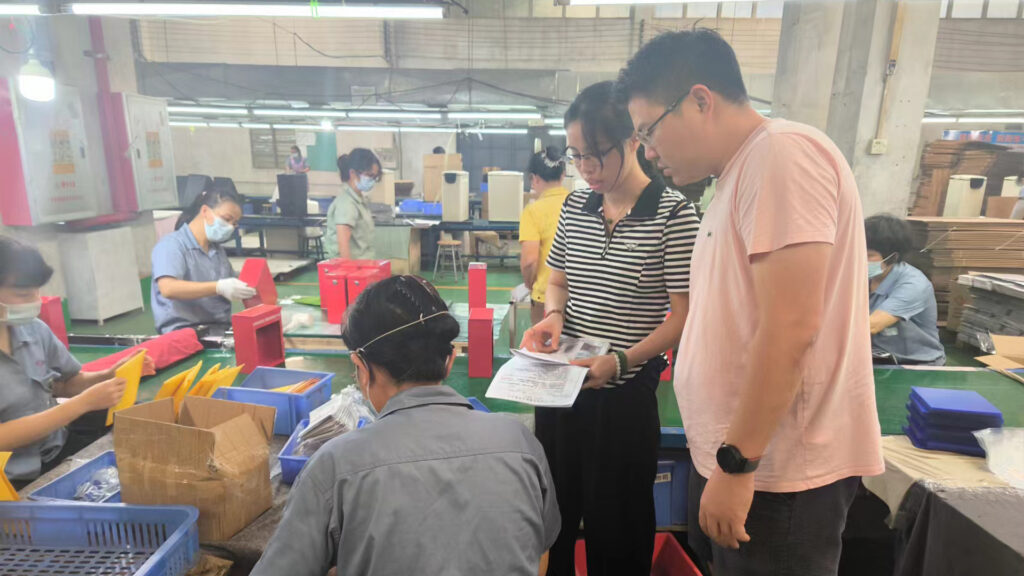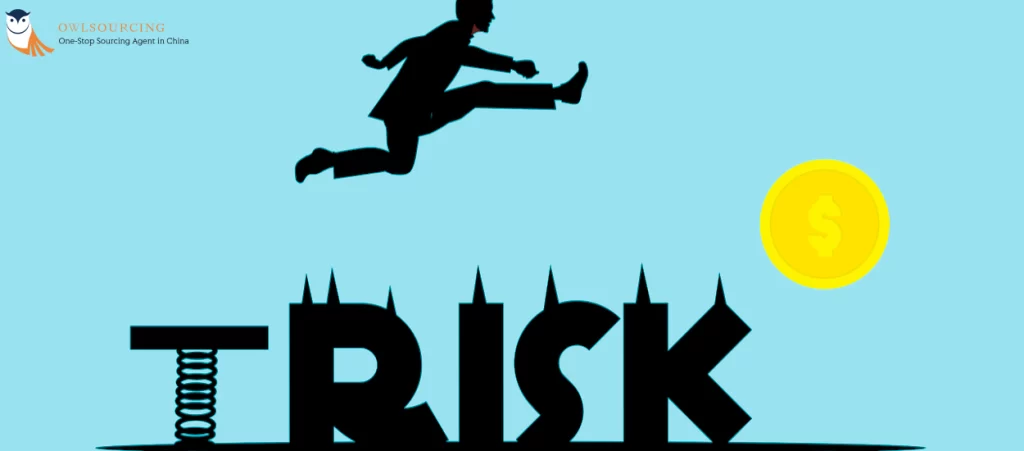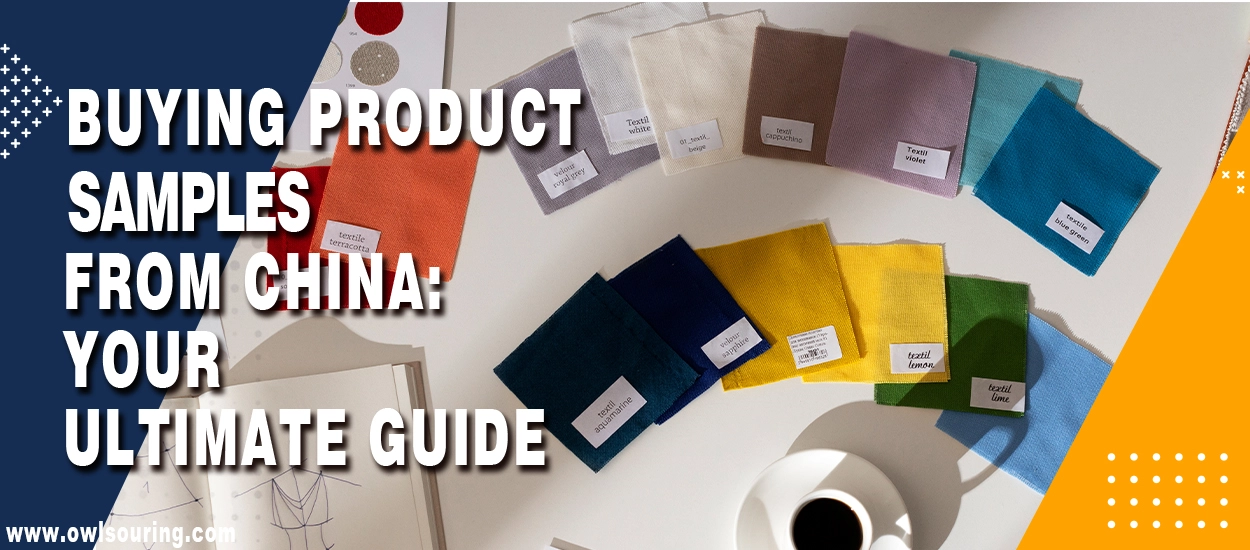If you’re interested in or considering importing products from China, then buying product samples from China should also be important for you. By using pre-production samples, you can test whether the supplier you’ve chosen is qualified.
In this guide from Owlsourcing, you will gain a deeper understanding of buying product samples from China and receive a comprehensive analysis of how to buy stuff from China.
What Are the Types of Product Samples Available?

1. Reference Samples from the factory
Standard or existing products that a factory can provide as a quality benchmark or example of their work.
2. Custom-Made Product Samples
Specifically produced based on a buyer’s unique specifications, often used to assess the manufacturer’s ability to create a product to exact requirements.
3. Counter-Samples
Samples that a manufacturer creates as a response to the buyer’s reference sample, to show that they can replicate the design with their materials.
4. Virtual Samples
Digitally created previews of products, often using 3D modelling or similar technology, allow for a visual representation without a physical sample.
Things you need to know: Innovations with 3D-printed Product Samples
Cycling Accessories
The company Fizik, in collaboration with Carbon, has developed superior bike saddles using 3D printing. They used a technology called Digital Light Synthesis (DLS) to create saddles with multiple functional zones, each designed for specific mechanical properties to improve performance and comfort.
Data from: amfg.ai
In the Automotive Industry
Porsche has used the technology of 3D printing in the design and production of automotive seats.
To achieve this, they used thermoplastic polyurethane (TPU) in seats which had varying stiffness; they were also planning to enhance the production of the seats that fit the customer’s body shape perfectly.
Such a level of personalization can be achieved only with the help of the modern 3D printing technologies.
The immense opportunity that 3D printing brings to the creation of product samples that are not only accurate but more importantly, accurately modelled to optimal use and any unique need.
The technology here also facilitates prototyping and personalisation, which shortens the time required to develop products and cuts the costs, as it also enhances product quality and performance.
5. Preproduction samples
These are pre-production series that are produced and tested before manufacturing begins, concluding with the final review of quality and specifications.
6. Other Sample Types
This may be promotional samples that are used in marketing, sample material used for quality control, or any other specific to the type of industry or product.
Exploring Different Product Sample Categories
When venturing into buying product samples from China, it’s helpful to understand the various sample categories available. Let’s explore each category and its significance:
1. Factory Samples: Understanding Their Significance

Factory samples mean that existing products manufactured are used by the company to present the capabilities of the manufacturer or the type of products that the company produces.
These samples are easy to obtain and can be incorporated as a tool to determine the quality, workmanship, and materials used by the factory in question.
Factory samples are very useful when you are seeking stock items or whenever you are out hunting for possible suppliers.
Whenever you order samples, you will be in a position to understand how the manufacturer handles their production line, packaging, and the general quality of the item you are interested in.
This helps you to come up with the right decisions on whether to order from a particular factory or not with respect to your brand.
2. Custom-Made Product Samples: Tailoring Your Vision
If you have unique design specifications or require custom-made products, ordering custom-made product samples is essential. This category of samples involves communicating your vision, specifications, and design requirements to the manufacturer.
Custom-made product samples allow you to evaluate how well the supplier understands your needs and their ability to translate them into tangible products. It also provides an opportunity for feedback and iterations before moving forward with bulk orders.
3. Production Samples: Ensuring Mass Quality
Once you’ve finalised a supplier and are ready to proceed with larger orders, production samples become crucial in ensuring mass quality consistency.
These samples act as reference points for factories during mass production. Production samples should represent the exact specifications, materials, finishes, and packaging that will be used in bulk manufacturing.
By thoroughly inspecting these samples for quality standards before giving final approval for mass production, you can minimise any potential issues or discrepancies down the line.
4. Other Sample Types
Apart from factory samples, custom-made product samples, and production samples, there may be other sample types worth considering depending on your specific needs:
- Prototype Samples: In new product development situations or when one is redesigning a product, sample prototypes can come in handy in creating the design before full implementation.
- Material Samples: If your product requires specific quality and suitable material, the sending of the material samples allows for evaluating its practical suitability for the intended use, its softness or hardness, similarity of the colours to the originals, and general appearance.
- Packaging Samples: It is useful for products that involve certain packaging designs or specific branding; requesting packaging samples lets you see how they perform in person. It serves to cover the product in a manner that would reflect the image of your brand to its customers as they unbox your product.
OwlSourcing: Simplify Your Product Sourcing Journey
Are you on the hunt for an effective method to connect with reliable manufacturers, secure competitive quotes, and organise your product-sourcing cycle? Your search ends with OwlSourcing.
Our Simple Sourcing service can help bring your ideas to life, from concept through delivery. Whether you are a startup or an established business, we provide a comprehensive solution to save you time, money, and most importantly, unnecessary stress.
What We Do
At Owlsourcing, we handle everything related to sourcing from scratch to product development, so you can pay more attention to what really matters: growing your business. Here’s how we make that happen:
- Product Development: We develop highly detailed product spec sheets from your unique vision.
- Supplier Connection: We identify, validate, and connect you with the right and reliable manufacturers for your needs.
- Sample Management: We manage sample orders and ensure every minute detail aligns with your expectations.
- Quality Assurance: From inspection to product testing, we make sure your products are of the highest standards.
- Negotiation: We will handle the price and terms negotiation for you to get the best deals.
- Shipping Logistics: From finding a freight forwarder to the delivery of your products, we manage end-to-end shipping solutions.
Why Choose OwlSourcing?
Setting up a new business and expanding the current one is a difficult job. Finding trustworthy products and suppliers should not be one of them. That is why our services are pegged on ensuring that this sourcing burden is taken off your shoulders.
We manage all the complexities that come with manufacturing in China so you can grow your operations without limits.
Who We Help
We have experience serving clients ranging from:
- Startups
- Retailers
- Amazon FBA sellers
- Entrepreneurs starting with their first product
Let’s Make It Happen
At OwlSourcing, we pride ourselves on being more than just a sourcing service but a partner in your journey of building a successful business. Ready to get started? Have questions for us? Reach out today and let us know how we can help bring your ideas to life.
Take the first step to frictionless sourcing. Let’s make your ideas real!
Preparation Before Sample Ordering from China
A particularly important piece of knowledge that has to be mastered before placing the order is the types of product samples. Here are the main types:
- Development Sample: The first run of your product to test the quality and idea.
- Pre-Production Sample: An enhanced sample after changes, after all the factors have been addressed.
- Pre-Shipment Sample: The final verification point before going to mass production to ensure all is okay.
This means that when one is developing product specifications, one should include aspects like size and type of material to use before contacting suppliers. It will be most beneficial to the construction process if the design files and as many details as possible are provided to avoid confusion.
How to Get Product Samples from Chinese Suppliers?

Here are some key points to consider for buying product samples from China:
- Payment Terms: For samples under $1500, you usually pay upfront, but for more expensive tooling samples (like injection moulds), payment is often split into two parts.
- Cost of Samples: Sample costs can vary widely, from $10 to several thousand dollars, depending on whether new tooling is required. For example, garment samples can range from $20 to $150, and electronics from $800 to $6000.
- Protecting Your Design: It is wise to have suppliers sign an NDA, but these are difficult to enforce without legal help. Registering patents and trademarks in all major markets, including China, offers the best protection.
- Supplier Competence: It’s recommended to order samples from multiple manufacturers to compare their quality and capabilities, especially in industries like apparel, where the failure rate can be high.
- Delivery and Customs: Samples are generally delivered by airmail, and you may need to pay import duties depending on the value of the samples and your country’s regulations.
Sending the Sample Request: Communicating with Suppliers
When contacting suppliers:
1. Communicating Precise Product Specifications
When seeking product samples, one has to be very clear. This means unearthing precise details of measurements, types of material to be used, colour, and any other extra features wanted.
Effective communication will assure the supplier that they are delivering samples that you want to see, hence achieving your expectations. In SHORT:
- Be Clear and Concise: Stick to details such as the type of material used, the size, and colours.
- Ask About Pricing and MOQs: Learn about sample prices and minimum quantity requirements.
- Request Visuals: You can request product photos or videos before they place orders for the sample products.
- Request a Sample: Make sure that they are of high quality and that they are as per your product conception.
- Such an approach forms a bond with the suppliers that helps to improve service delivery and probably offers better prices in later transactions.
2. Collaborative Product Development with Suppliers
Accessibility, cooperation, and communication should be maintained in the course of sampling. This makes it possible for you to be in constant communication with the intended participants to give your feedback and forward your amendments as you all strive to realise the intended objectives.

However, it is prudent to take all the necessary precautions in making sure that you do not disclose information to your suppliers by signing NDAs or applying for patents/trademarks of the products.
To avoid being on the receiving end, it is wise to seek the services of lawyers who practice in intellectual property law.
4. Handling Supplier Refusals for Samples
Sometimes, some of these suppliers may be reluctant to offer free samples for various reasons, which include high costs of production or poor protection of IPR.
In any of these circumstances, it is necessary to engage in bargaining for or compromise with other arrangements. You can offer to pay for the sample or contribute towards the cost of shipping, where the case applies.
The following are the trade stimuli that should be considered and implemented to overcome the trade hitches: The trade hitches that might manifest themselves include:
5. Sourcing Samples from Multiple Chinese Manufacturers
It is advisable to order samples from different manufacturers in China at once to be in the best position when it comes to choosing the right manufacturer to meet your product requirements.
With this system, you can determine which of the suppliers has the best quality and the most compatible prices, time frames, and overall compliance with your business needs.
Sample Request: Receiving, Inspecting and Testing
Receiving the Sample:
- Negotiate Shipping Costs: Knowing who bears the cost of shipping.
- Track the Shipment: Always make sure that you have tracking details.
- Prepare for Customs: Consider any possible costs involved when making use of the power of a rigid plan.
Inspecting the Sample:
- Quality Check: Make sure that the material you’re using, plus the apparatus, satisfy your requirements.
- Accuracy: Make sure the product meets the given specifications, if any.
- Look for Defects: Can notice any flaws or problems that might occur if the scale of an order was created with it.
Testing the Sample:
- Evaluate Durability: Is the nature or the material as described?
- Test Functionality: Make sure that it complies with expectations.
Feedback on the Supplier:
- Positive Feedback: The supervisor may want to appreciate workers if the sample meets the required benchmark.
- Constructive Criticism: When demanding changes that must be made, be descriptive and formal; if there are possible corrections, present them.
Place Your Bulk Order (If Satisfied):
Confirm Final Specifications: Memorisation is not a good practice here; it is therefore important that every detail is written down and agreed upon.
- Negotiate Payment Terms: Be aware of details related to deposits and payment periods.
- Arrange for Quality Control: You should also think about hiring a third-party inspector to ensure that the products meet the required standards.
Notes from Owlsourcing: Can I order product samples on Alibaba? And is it free of charge?
Yes, some sellers on Alibaba allow clients to order product samples, but such options are usually not free.
Many suppliers will expect you to pay for the sample, hoping that this will attract the numerous inquiries most of them receive.
Remember that samples are usually 10-50% more expensive than orders of a more extensive quantity, as samples are individual and the extra price proves the buyer’s seriousness.
Also, we need to factor in the carriage costs, though these could be high even when moving small volumes.
How to Order Samples from Alibaba: A Step-by-Step Guide
Ordering samples from Alibaba is one of the crucial steps to ensuring product quality before making a larger order. Here is a smooth way through which you can get samples from Alibaba:
Alibaba Sample Ordering Process

- Identify Suppliers: Search for and select suppliers who offer the product you’re interested in.
- Negotiate Sample Costs: Contact suppliers to discuss sample availability and costs.
- Provide Details: Communicate your requirements and specifications for the sample.
- Confirm Terms: Agree on payment terms, shipping methods, and any customisation needed.
- Testing: Once received, thoroughly inspect and test the sample.
- Feedback: Provide feedback to the supplier on the sample and negotiate any necessary changes for mass production.
Important Considerations
Expect Sample Fees:
Most suppliers will charge for samples as it covers their production and shipment costs. Be prepared to pay, since this shows that you are a serious buyer.
Verify Supplier Reputation:
Before placing the order, ensure that the supplier is reliable based on reviews, ratings, and transaction history on Alibaba.
Clear Communication is Key:
Provide detailed instructions and confirm all terms to avoid misunderstandings.
Use Alibaba’s Trade Assurance:
It offers added protection, ensuring the product quality and allowing refunds if the supplier does not meet the agreed standards.
These steps will let you confidently order samples from Alibaba and ensure they are up to your quality and business needs before making a greater investment.
How much does it cost to buy Product Samples from China?

Should You Pay for Samples?
Basically, you will be expected to pay for samples, but with exceptions. Whether you pay and how much depends on your negotiation with the supplier. Here’s a breakdown to guide you:
Do You Always Have to Pay for a Sample?
- Free Samples: The suppliers give free samples as a goodwill gesture, but this mostly applies to standard products or smaller items.
- Paid Samples: The majority of suppliers are going to have a sample fee for their products. This can be as low as a small amount with shipping or a full retail or higher cost.
- Air Freight: Most sample shipments are by air to expedite the shipment, and can be expensive. Shipping of small items can cost $50 to $100, and larger items can cost many hundreds of dollars.
- Revised Samples: If a sample needs to be revised, additional shipments can increase your overall cost.
Discover “What to Expect When Shipping Samples from China“—Click to Learn More!
1. Payment Options for Acquiring Product Samples
When ordering product samples from China, payment options can vary depending on the supplier. Common methods include wire transfers, PayPal, or using a trusted trade assurance platform like Alibaba.com.
It’s important to choose a secure payment method that offers buyer protection.
- Pay Using PayPal: The use of PayPal for paying for samples provides good buyer protection and is, therefore, trustworthy.
- Ask for Sample Price Deduction: Try to negotiate with the supplier if the sample cost can be deducted from your first bulk order.
2. Import Duties and Taxes for Imported Samples
Import duties and taxes are additional costs to consider when importing samples from China. The exact amount varies based on your country’s regulations and the declared value of the samples.
Research your country’s customs laws or consult with a customs broker to estimate these costs accurately.
3. Estimating the Costs of Chinese Product Samples

The cost of product samples can vary significantly depending on factors such as complexity, customisation, materials used, and shipping fees.
It’s advisable to request a comprehensive quotation from suppliers that includes all relevant expenses. This will help you make informed decisions and prevent any unexpected financial surprises.
Why Paying for Samples is Worth It
While sample costs may seem high, they are a necessary investment in quality assurance. Spending money on the front end allows you to identify and correct any issues, saving costly revisions or dissatisfaction later.
Pro Tip: While the sample cost may seem high, it ensures your final product meets expectations.
Maximising Cost Efficiency in Sample Prototyping
Efficient sample prototyping allows you to streamline the process while minimising costs. Consider implementing the following strategies:
A. Streamlining the Delivery of Your Product Samples
Consolidate multiple sample orders into one shipment whenever possible. Consolidating shipments from China reduces shipping costs and saves time during customs clearance procedures.
B. Simplifying Import Duties and Taxes for Samples
To simplify import duties and taxes, work closely with a reliable China shipping agent or customs broker who can guide you through the process.
They will ensure compliance with regulations while optimising cost efficiency.
The Importance of Ordering Product Samples from China
However, it is vital that before going through the specific procedures of ordering the product samples from China, you know why it is important to order product samples.
- Quality Assurance: It is often difficult to evaluate the quality of Chinese products and to make an order based on the pictures and a text description only.
You can prove the composition of the product and the general quality of its manufacturing through sample requests from the companies.

- Assessing Supplier Capability: Sampling allows you to measure a supplier’s ability to meet your requirements.
Manufacturer samples help determine if they can produce goods that meet your specifications and standards.
- Test Market Viability: Before committing to a bulk order or launching a new product line, testing market viability is important.
By getting product samples, you can gather feedback from potential customers and assess demand before making larger investments.
- Product Customisation: If you have specific design requirements or want custom-made products tailored to your vision,
Buying Product samples enables you to communicate your needs effectively and fine-tune the outcome.
Tip: If you are not good at Chinese, Owlsourcing has a professional sourcing team in China that will help you negotiate your product needs with Chinese suppliers.
When Is the Right Time to Order Product Samples?
You should order samples after conducting thorough market research, but before committing to large-scale production.
This allows you to validate the market demand for your product and make any necessary modifications based on customer feedback.
Professional Sample Order Help
Dealing with Alibaba sample orders and purchasing samples on Alibaba, especially quality assurance through China product testing and samples inspection in China, may be tough.
We at OwlSourcing are professionals at China product preparation for buying wholesale from China, offering seamless China product prep services to help you purchase products from China easily.
Whether you are buying products from China, requesting free samples from suppliers, or evaluating paid sampling, our experience ensures hassle-free transactions and quality control.
If you are unsure how to buy products from China or require guidance on sample costs, we provide one-on-one support to optimise your sourcing process.
Contact us today to simplify your Alibaba samples and boost your competitive edge in your industry!
Read More:
- How To Import Bags From China: A Detailed Guide
- How to Verify a Chinese Supplier’s Legitimacy?
- What Should You Expect When Shipping Samples From China?
- China Sourcing Agent Fees
Final Thoughts
Through the above article, you now have a comprehensive understanding of buying product samples from China. So, are you ready to source products from China?
Owlsourcing is here to help you with all your concerns. Please feel free to contact us.



2 thoughts on “How to Order Your First Product Sample from China?”
Which city in China offers the most favorable tax rates for importing health products as samples?
Hello Madonna,
Shenzhen, known for its favorable tax policies and status as a Special Economic Zone, is often considered the best city in China for importing health products as samples with advantageous tax rates.
😊